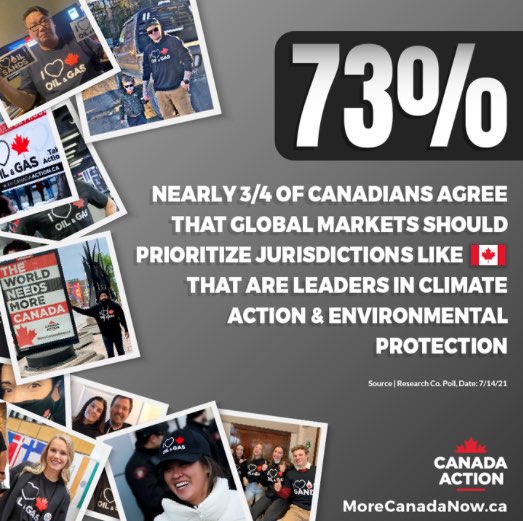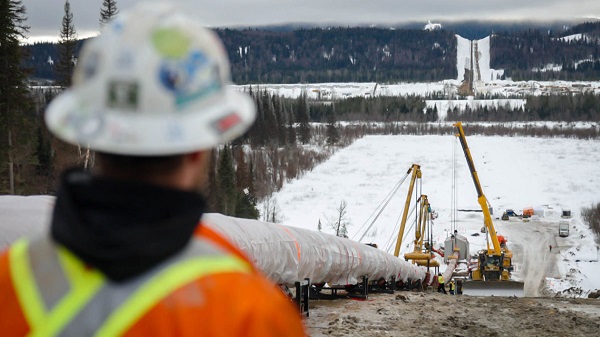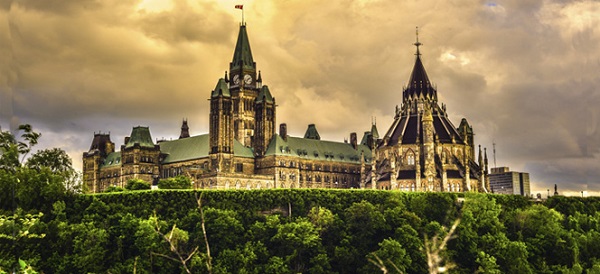Alberta
New opinion surveys reveal overwhelming majority of Canadians support our Oil and Gas industry

News Release from Canada Action
We are very excited to share some recent and encouraging polling results today. According to a July 2021 public opinion survey conducted by Research Co, new data shows that Canada’s public perception of our responsible energy industry is very positive.
Here are some of the key findings:
- Almost three in four (73 percent) Canadians polled agree Canada should be a preferred global supplier of energy because of its climate and environmental record.
- Nearly seven in ten (69 percent) say they have personally benefited from the oil and gas sector.
- 70 percent agree that resource development could help alleviate systemic poverty within Indigenous communities.
- Two thirds of Canadians (66 percent) support Canada’s role as a global oil and gas supplier.
- Almost three in four Canadians (73 percent) acknowledge Canada’s prosperity is supported by the oil and gas sector and that Canadian oil and gas production helps fund important social programs like health care and education.
Referring to the fact 73 percent of Canadians polled also agreed it’s essential First Nations be included in project development to establish long-term revenue sources for their communities, JP Gladu, acting Executive Director of Indigenous Resource Network, noted the following:
Taken collectively, this is all exceptional news for all of Canada’s natural resource industries. Your support for our positive, fact based message about why the world needs more Canadian energy and resources is helping make a difference.
A Majority of Canadians ‘Agree’ that Canada Should be a Preferred Global Supplier of Energy: POLL

A new public opinion survey conducted by Research Co. on behalf of Canada Action has found that a majority of Canadians across the country support the vital oil and gas sector! The poll, released on July 14th, showed that 68% of participants ‘agree’ that Canada should be the choice supplier to meet future oil and gas demand, while two-thirds (66%) support Canada’s role as a global oil and gas supplier versus just 19% who were opposed.
Additionally, almost three in four Canadians (73%) acknowledged Canada’s prosperity is supported by the oil and gas sector and that the industry helps fund important social programs such as healthcare and education.
“It’s a strong and very welcome result, and one that shows most Canadians feel proud of the work their energy sector is doing to enhance its record on ESG criteria. The results also show most Canadians believe the world needs more Canadian energy and are aware of the importance of the sector to the prosperity of families and communities right across the country,” said Cody Battershill, Canada Action founder.

Between 2000 and 2018, approximately $493 billion in government revenues were generated by Canada’s oil and gas industry, capital which has been used pay for schools, hospitals, roads and the workers that make these projects possible/operational. Every Canadian has benefitted from oil and gas in some way, shape, or form; nearly seven-in-ten Canadians (69%) of participants also acknowledged that Canada’s oil and gas sector has benefitted them personally.
Nearly three-in-four Canadians (73%) also agreed that global markets should prioritize jurisdictions like Canada that are leaders in climate action and environmental protection. This is a logical choice as Canada’s oil and gas industry ranks number one for Environmental, Social, and Governance (ESG) practices among nations with the largest oil reserves, and of the world’s top 20 producers, 2nd for governance and social progress and 4th on the environment.
“Given the world requires $525 billion of new oil and gas investment per year just to meet current demand, we think we ought to push for Canada to receive a sizeable share of this investment,” Battershill added.

Canada’s world-class ESG performance shows that our nation is home to one of the most environmentally conscious and sustainable oil and gas industries in the world. With future supply gaps on the horizon, it only makes sense that ESG-focussed investors look to Canada as a choice supplier for as long as the world needs oil – and it will for many decades to come.
73% of participants also agreed that it’s essential First Nations be included in project development to establish long-term revenue sources for their communities.
“These are heartening results. Indigenous nations and businesses want to be partners in resource development. This poll shows there’s widespread support to work together for the benefit of all,” said JP Gladu, acting Executive Director of the Indigenous Resource Network.
Below is a summary of all poll results collected by Research Co.
Poll Results:

– Two-thirds of Canadians (66%) support Canada’s role as a global oil and gas supplier, while one-in-five (19%) are opposed
– Almost seven-in-ten Canadians (69%) say the oil and gas industry has benefitted them personally
– Almost three-in-four Canadians (73%) agree that global markets should prioritize jurisdictions like Canada that are leaders in climate action and environmental protection
– Almost three-in-four Canadians (73%) agree that Canadian oil and gas products help fund important social programs like healthcare and education for Canadians
– More than seven-in-ten Canadians (72%) agree that sustainability measures are better served when energy is sourced from Canada compared to less environmentally friendly jurisdictions

– Seven-in-ten Canadians (70%) agree that Canada should be the choice recipient of investments due to its climate leadership and environmental policies
– More than two-thirds of Canadians (68%) agree that Canada should be the choice supplier to meet future oil and gas demand
– Over three-in-five Canadians (64%) agree that investing in Canada’s oil and gas sector makes sense if you value climate leadership, social progress and transparency
– Fewer than half of Canadians (45%) were aware that Canada is a leader for environmental, social and governance (ESG) practices among countries with the largest oil and gas reserves
– More than two-in-five Canadians (43%) were aware that Canadian energy companies are global leaders in carbon capture, utilization and storage

– Just over two-in-five Canadians (41%) were aware that Canadian natural gas exported to Asia can reduce global emissions by displacing coal power usage
– Almost three-in-four Canadians (73%) agree that global markets should prioritize jurisdictions like Canada that are leaders in climate leadership and environmental protection
– Almost three-in-four Canadians (73%) agree that Canada should be a destination of choice for energy investment due to its climate leadership, worker safety and environmental policies
– More than two-thirds of Canadians (68%) agree that Canada should be the choice supplier to meet future oil and gas demand
– Almost three-in-four Canadians (74%) think Canada should act in a similar fashion to Norway when it comes to energy practices, as the nation has said they will continue to maximize the value created from their oil and gas reserves

– Almost three-in-four Canadians (73%) agree that Canada’s prosperity is supported by the oil and gas sector practices
– Almost three-in-four Canadians (73%) agree that it is essential that First Nations be included in project development to establish long-term revenue sources for their communities
– Seven-in-ten Canadians (70%) agree that Systemic poverty within Indigenous communities could be alleviated with resource development
– Almost seven-in-ten Canadians (69%) agree that Indigenous and non-Indigenous communities in Canada should play a role in supplying our energy to meet domestic and global demands
– More than half of Canadians (56%) agree with the decision related to the TMX expansion, while one-in-five (21%) disagree, and a similar proportion (22%) are undecided. Support for the decision is highest in Alberta and Atlantic Canada (each at 63%), followed by Ontario (57%), Saskatchewan and Manitoba (56%), British Columbia (55%) and Quebec (52%)
– Over three-in-five Canadians (62%) think the Indigenous communities support the Trans Mountain Pipeline (TMX) project
– More than three-in-ten Canadians (31%) are more likely to support the Trans Mountain expansion upon learning of the views of Indigenous communities, while 7% are less likely to support. More than two-in-five (47%) say their position has not changed as a result of this fact
Results were based on an online study among 1,000 adults in Canada, conducted July 7 to 9, 2021 and weighted for age, gender and region. The margin of error—which measures sample variability—is +/- 3.1 percentage points, nineteen times out of twenty.
Join Us Today!
Learn more about Canada’s sustainable energy industry by joining us on Facebook, Twitter, and Instagram today – hope to see you there!
Back to Energy – Canada Action
Alberta
Owner sells gas for 80 cents per litre to show Albertans how low prices ‘could’ be

Undoubtedly some of the motorists driving past The Whistle Stop Cafe at Mirror on Tuesday morning thought it was an April Fools prank. It wasn’t.
Chris Scott, owner of the gas station at The Whistle Stop Cafe offered a one day promotion on April 1st. Scott sold 8000 litres of regular gasoline for $0.80/ litre.
The promotion was funded by Scott and the Alberta Prosperity Project. In this video posted to his social media, Chris Scott explains why they did it.
Alberta
The beauty of economic corridors: Inside Alberta’s work to link products with new markets

From the Canadian Energy Centre
Q&A with Devin Dreeshen, Minister of Transport and Economic Corridors
CEC: How have recent developments impacted Alberta’s ability to expand trade routes and access new markets for energy and natural resources?
Dreeshen: With the U.S. trade dispute going on right now, it’s great to see that other provinces and the federal government are taking an interest in our east, west and northern trade routes, something that we in Alberta have been advocating for a long time.
We signed agreements with Saskatchewan and Manitoba to have an economic corridor to stretch across the prairies, as well as a recent agreement with the Northwest Territories to go north. With the leadership of Premier Danielle Smith, she’s been working on a BC, prairie and three northern territories economic corridor agreement with pretty much the entire western and northern block of Canada.
There has been a tremendous amount of work trying to get Alberta products to market and to make sure we can build big projects in Canada again.
CEC: Which infrastructure projects, whether pipeline, rail or port expansions, do you see as the most viable for improving Alberta’s global market access?
Dreeshen: We look at everything. Obviously, pipelines are the safest way to transport oil and gas, but also rail is part of the mix of getting over four million barrels per day to markets around the world.
The beauty of economic corridors is that it’s a swath of land that can have any type of utility in it, whether it be a roadway, railway, pipeline or a utility line. When you have all the environmental permits that are approved in a timely manner, and you have that designated swath of land, it politically de-risks any type of project.
CEC: A key focus of your ministry has been expanding trade corridors, including an agreement with Saskatchewan and Manitoba to explore access to Hudson’s Bay. Is there any interest from industry in developing this corridor further?
Dreeshen: There’s been lots of talk [about] Hudson Bay, a trade corridor with rail and port access. We’ve seen some improvements to go to Churchill, but also an interest in the Nelson River.
We’re starting to see more confidence in the private sector and industry wanting to build these projects. It’s great that governments can get together and work on a common goal to build things here in Canada.
CEC: What is your vision for Alberta’s future as a leader in global trade, and how do economic corridors fit into that strategy?
Dreeshen: Premier Smith has talked about C-69 being repealed by the federal government [and] the reversal of the West Coast tanker ban, which targets Alberta energy going west out of the Pacific.
There’s a lot of work that needs to be done on the federal side. Alberta has been doing a lot of the heavy lifting when it comes to economic corridors.
We’ve asked the federal government if they could develop an economic corridor agency. We want to make sure that the federal government can come to the table, work with provinces [and] work with First Nations across this country to make sure that we can see these projects being built again here in Canada.
-

 2025 Federal Election2 days ago
2025 Federal Election2 days agoJoe Tay Says He Contacted RCMP for Protection, Demands Carney Fire MP Over “Bounty” Remark
-

 2025 Federal Election2 days ago
2025 Federal Election2 days agoHong Kong-Canadian Groups Demand PM Carney Drop Liberal Candidate Over “Bounty” Remark Supporting CCP Repression
-

 2025 Federal Election2 days ago
2025 Federal Election2 days agoPoilievre To Create ‘Canada First’ National Energy Corridor
-

 2025 Federal Election2 days ago
2025 Federal Election2 days agoAlcohol tax and MP pay hike tomorrow (April 1)
-

 2025 Federal Election2 days ago
2025 Federal Election2 days agoChina Election Interference – Parties Received Security Briefing Days Ago as SITE Monitors Threats to Conservative Candidate Joe Tay
-

 2025 Federal Election2 days ago
2025 Federal Election2 days agoFixing Canada’s immigration system should be next government’s top priority
-

 2025 Federal Election1 day ago
2025 Federal Election1 day agoPoilievre, Conservatives receive election endorsement from large Canadian trade union
-

 Bruce Dowbiggin2 days ago
Bruce Dowbiggin2 days agoAre the Jays Signing Or Declining? Only Vladdy & Bo Know For Sure







